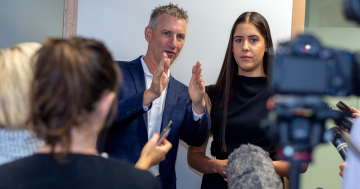McKinley Valentine* says procrastination and low motivation make productivity difficult, but body-doubling might help
 I struggle with procrastination. Even when I know a task is really important, understand its value, and want to do it, getting started still feels like walking into a 60km/hr headwind.
I struggle with procrastination. Even when I know a task is really important, understand its value, and want to do it, getting started still feels like walking into a 60km/hr headwind.
I struggle with procrastination because I have ADHD, but here’s a few other potential triggers: depression, illness, stress, anxiety, grief, disruptions to routine, increased childcare responsibilities, loss of external structure, financial worries…
But who’s experienced any of that over the past year? Hahahahahahaha *starts crying*.
The good news is that people with ADHD have a toolkit for fighting procrastination, and they’re tools anyone can use.
Body-doubling is one of my favourites.
What is body-doubling?
Body-doubling is simply having another person in the room with you, working quietly alongside you.
They can work on something similar, or something completely different.
They can read a book or knit.
They’re not there to judge you or nag you, they’re just … there.
And it works.
I don’t know how other writers get by without it.
If I’m dreading a task, I still dread it, but I manage to get started and get through it.
Sometimes grudgingly and laboriously, sometimes with surprising ease.
Either way, the feeling at the end of a session, of knowing I’ve put a real dent in the thing I’ve been procrastinating on, is a massive relief and a positive outlook on the rest of the day.
Why does it work?
One element of why body-doubling is effective is accountability, both the very gentle pressure of your body-double’s presence and the knowledge that you only have limited time with them.
If you’ve made an appointment, you’ll show up just so you don’t let them down.
(Anyone who’s booked a live online yoga class instead of using pre-recorded videos understands this one).
There haven’t been any peer-reviewed studies into body-doubling, but ADHD coach Linda Anderson believes that body-doubles model a calm, focused presence, which the other person unconsciously mirrors.
Ms Anderson coined the term in 1996 not long after the discovery of mirror neurons, and it’s since become a widely recommended technique.
“If you have another human being with you, it seems to be the magic ingredient that allows you to get your work done. They’re an anchor,” she says.
They’re also a visual reminder to stay on task, like a giant, human-shaped post-it note.
Virtual body-doubling is almost as effective
You don’t need to be in-person for body-doubling to work.
Phone calls and video calls can be just as effective.
During the first lockdown, I had Zoom sessions every Wednesday with a writer in LA — my morning, his afternoon.
I’d feel great about getting through a chunk of work so early in the day, which made it easy to keep the ball rolling after the call ended.
There are now quite a few online groups organising co-working sessions, either free or with a monthly membership fee.
Tom, a science communicator with ADHD, found working at home during lockdown tough because he thrives in a team environment.
“When you’re at home, you’re not in a ‘job’ space, you’re in an ‘everything’ space,” he says.
“Virtual co-working sessions shift me back into the ‘job’ context. The structure and accountability give me that extra little push I need to get started and stay focused.”
How can body-doubling help at work?
Particularly if you’re working from home, booking in with a body-double might help give some structure to your workday.
“I have clients who’ve set up a regular work period with a friend or colleague,” Ms Anderson says.
She suggests body-doubling is very helpful for “stationary projects” like writing or computer-based work, but can work when you’re on the go too.
“You can also put a phone in your pocket to do something physical like organising a space,” Ms Anderson says.
You could schedule a body-doubling session at the beginning of each workday to help kick-start your motivation and have another one about 2:00pm, if that’s when your energy starts to flag.
If there are some tasks you always struggle with, like processing emails (which you’re right to struggle with because it sucks), then you could set up a twice-weekly session just for that task.
There are even YouTube videos of someone just quietly working for an hour, which you can leave playing on a dual monitor set-up.
But it’s also great for:
- A side project that you’re passionate about, but can’t seem to get started on.
- Life admin that’s piling up, or something you typically put off, like paying bills.
- Physical tasks, like meal prep, decluttering or folding washing.
How to get the most out of a body-doubling session
You can just flag down the nearest housemate, but sessions are most effective when you make an appointment and decide in advance what you’ll work on — if you show up with the vague intention to do “stuff you’ve been meaning to do”, you’ll get less out of it.
The ‘deadline effect’ also motivates you to do some pre-work before the appointment.
Start the session by telling the other person what you plan to work on.
Set a three-minute timer.
During that three minutes, put your phone in another room so it’s not a distraction, pour a glass of water and close any irrelevant programs and tabs on your computer.
Work in timed bursts of 20 to 45 minutes and at the end of each burst, check-in with each other.
If you didn’t get much done, can you identify what blocked you, and think of a way to neutralise it?
Don’t give up
One final tip: as the appointment approaches, you might find yourself thinking, “I shouldn’t have booked this in for today. I’m really not in the mood to work, so it’ll be a waste of time.”
You might even feel suddenly drowsy but don’t cancel the session.
Those feelings are your aversion to starting the task rising up because you can see it approaching.
And it’s exactly those feelings that body-doubling is designed to overcome.
Ms Anderson suggests reducing resistance by starting with a very small commitment — 15 or 30 minutes — and setting a clear endpoint.
“But during that time, you commit to the work. Even if you just draw circles on a piece of paper and think about the project for that amount of time,” she says.
*McKinley Valentine is a writer for ABC’s Hard Quiz and author of the newsletter The Whippet.
This article first appeared at abc.net.au











